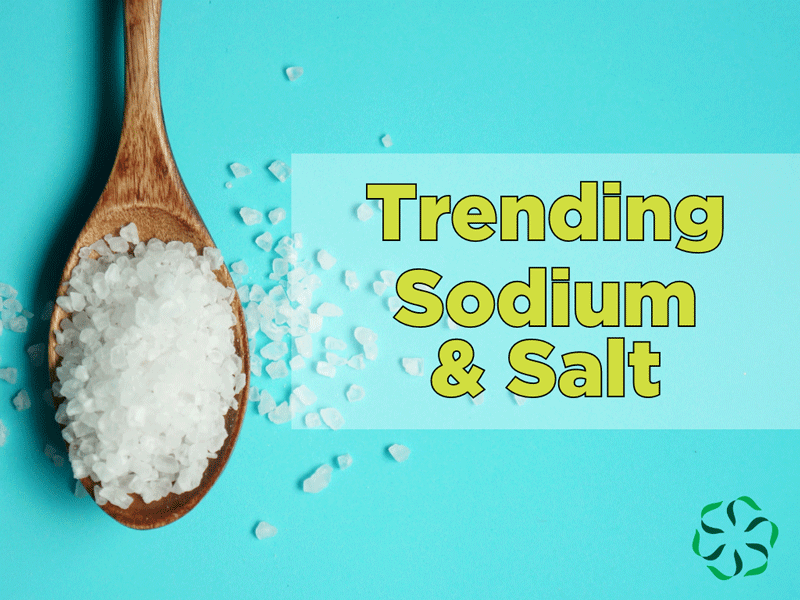In this post, we look at a staple ingredient, sodium.
What is sodium?
Sodium is a chemical element represented by the symbol “Na” on the periodic table.
It is an essential mineral and an electrolyte that plays a crucial role in various physiological functions in our bodies, such as maintaining proper fluid balance, nerve function, and muscle contractions.
It is one of the essential components of table salt (sodium chloride), but it also exists in many other foods and natural sources, like fruits, vegetables, and dairy.
Consuming too much sodium can lead to health issues such as high blood pressure and an increased risk of heart disease.
Do we need sodium in our diets?
Yes, sodium plays several crucial roles in maintaining our bodily health and is essential for life. Some of the key functions of sodium include:
- Maintaining fluid balance: Sodium helps to regulate the amount of water in the body. This is important for keeping blood pressure in a healthy range and preventing dehydration.
- Conducting nerve impulses: Sodium is essential for transmitting nerve signals throughout the body. This is important for muscle contraction, heart rate, and other bodily functions.
- Contracting and relaxing muscle: Sodium helps muscles to contract and relax. This is important for movement, digestion, and other bodily processes.
- Maintaining the proper pH balance of the blood: Sodium helps to keep the blood’s pH level in a healthy range. This is important for preventing medical conditions like acidosis and alkalosis.
Where do we find sodium in our diets?
Sodium is present in small amounts in fruits, vegetables, and dairy products. It’s commonly associated with processed and packaged foods, which often have high sodium content.
We can find sodium in ingredients, including,
- Monosodium glutamate (MSG)
- Sodium bicarbonate (baking soda)
- Sodium chloride (salt)
- Sodium nitrate
What is the difference between sodium and salt?
Sodium consists of a single element, Sodium (Na).
Common salt comprises at least two elements, Sodium and Chlorine to makeup Sodium Chloride (NaCl).
Therefore, salt contains sodium as one of its components.
What types of salts are there?
There are many salts available to us. Some salts contain not only Sodium Chloride (NaCl) but also additional elements like iron, magnesium, iodine, and various minerals, including,
- Celtic Sea Salt
- Himalayan Pink Salt
- Sea Salt
- Table Salt fortified with iodine
While most salts contain trace amounts of anti-caking agents to prevent clumping, certain salts don’t include any additional ingredients. These salts include:
- Kosher Salt
- Pickling Salt
The market offers a wide array of salt types, each with unique characteristics and mineral compositions.
Is sodium naturally occurring in foods and beverages, or is it added?
We find sodium in many foods, especially fruits, vegetables, and dairy products. In its natural state, sodium is not typically added to foods.
We add sodium to foods through salt or other sodium-containing additives like MSG. This serves various purposes, such as enhancing flavor, preserving food, and improving texture.
Processed and packaged foods, as well as restaurant meals, may contain higher amounts of added sodium compared to unprocessed natural foods.
Can we consume too much salt and sodium? What is the recommended level of sodium intake?
Consuming too much sodium is possible, but the ideal dietary intake varies for each individual based on current health and lifestyle habits.
Many health organizations recommend a daily sodium intake of 2.3 g/day or less for adults to maintain optimal health. Some studies suggest that exceeding this limit may adversely affect cardiovascular health (1).
However, there is ongoing debate surrounding this recommendation.
Other research indicates that a sodium consumption range of 3-5 g/day on a population level is associated with the lowest risk of adverse cardiovascular health. Nevertheless, surpassing 5 g/day of sodium has been linked to adverse health outcomes (1,2).
Furthermore, a separate study suggests that reducing sodium intake below 3 g/day might be connected to increased adverse health events (1).
Given the varying perspectives, it is recommended to consult a healthcare provider who can assist you in navigating your individual health needs.
Do we need to consume salt with iodine? Why is iodine added to salt?
Iodine is an essential trace mineral necessary for proper thyroid function.
In the early 1900s, the United States experienced a “goiter belt,” a cluster of states primarily in the Great Lakes, Appalachians, and Northwestern regions with high levels of iodine deficiency diseases (1).
In response to this concern, a coalition of Michigan doctors advocated to fortify salt with iodine. This proactive measure successfully reduced the incidence of iodine deficiency diseases (1).
While iodine can be found in other foods, processed foods high in sodium and/or salt are not typically fortified with iodine (1). As a result, seeking iodine from other dietary sources becomes necessary if you opt for non-iodized salt.
The good news.
The good news is that we can decide how we obtain the necessary sodium for our bodies by making thoughtful choices about the foods and salts we consume. By being mindful of our choices and maintaining a well-balanced diet, we can reap sodium’s benefits while minimizing potential health risks.
If you have any questions about foods and ingredients, please reach out to us on Twitter, send us an email, or submit your idea to us at go.msu.edu/cris-idea

